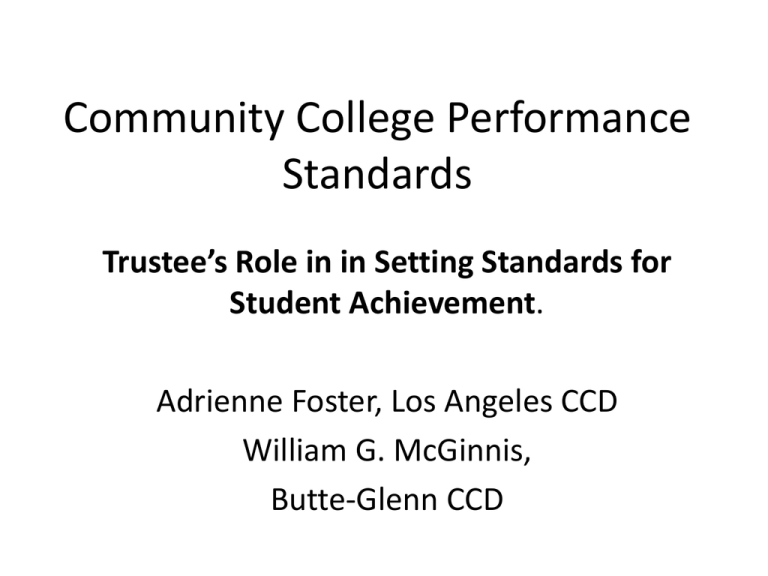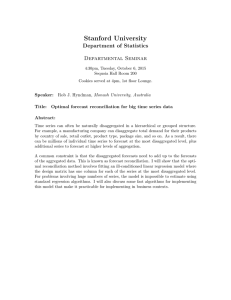Friday Breakout:Trustees` Role in Setting Standards for
advertisement

Community College Performance Standards Trustee’s Role in in Setting Standards for Student Achievement. Adrienne Foster, Los Angeles CCD William G. McGinnis, Butte-Glenn CCD Presentation Outline • • • • • The Mandated Data & Definitions Data Presentations Samples The Trustees’ Role & Responsibilities “What if” Discussion Conclusion Student Achievement Mandate • Community Colleges shall establish standards for student achievement (ACCJC requirement) • A standard is a level of performance that an institution determines it must meet. (Not a goal) • Should an institution not meet an adopted standard it must engage in high level institutional introspection. The Student Achievement Standards • • • • • • Student Course Completion Rates (%) Student Retention Rate (%) Student Degree Completion # Student Transfer to 4 yr college/university # Student Certificate Completion # Gainful Employment Data (USDE Proposal) Student Course Completion Rates (%) • The completion rate is calculated by dividing the number of students satisfactorily completing (with a grade of “C” or better) all courses by number of students attempting all the courses. • Significance – demonstrates ability of students to satisfactorily progress – predictor of graduation. • This data is computed by the District’s institutional research staff for each college. ABC Community College All Students - Course Completion Rate 100.0% 95.0% 90.0% 85.0% % Completed 80.0% 75.0% 70.0% 65.0% 60.0% 55.0% 50.0% All Students 08/09 65.0% 09/10 68.0% 10/11 71.2% 11/12 72.3% 12/13 74.5% Adopted Standard: 65.0% 65.0% 65.0% 65.0% 65.0% EFG College Student Completion Rates 100.0% 90.0% 80.0% 70.0% Percentage 60.0% 50.0% 40.0% 30.0% 20.0% 10.0% 0.0% 08/09 09/10 10/11 11/12 Course completion rate 73.0% 71.7% 73.3% 73.3% Standard 65.0% 65.0% 65.0% 65.0% 12/13 Student Retention Rate Measure • The student retention rate is calculated by dividing the number of students returning each Fall semester for class (less the number of graduates/transfer students) by the number of students enrolled in the previous Fall semester. • Significance: Demonstrates students’ timely progress towards completion. • The data is computed by the District’s institutional research staff for each college. GHJ Community College 100.0% Student Retention Rates 90.0% 80.0% Student Retention Rate 70.0% 60.0% 50.0% 40.0% 30.0% 20.0% 10.0% 0.0% 2007/08 2008/09 2009/10 2010/11 2011/12 2012/13 State Wide 57.3% 51.3% 51.3% 50.8% 49.2% 49.5% GHJ College 46.3% 43.6% 43.6% 47.4% 45.0% 46.0% College Standard 42.0% 42.0% 42.0% 42.0% 42.0% 42.0% Degree Completion Measure • The degree completion measure equals the number of degrees (AA/AS/AAT/AST) awarded annually by students at a college. • Significance: Measures students’ success in completing degree requirements and obtaining a post-secondary degree. • The data is calculated by the District’s institutional research staff for each college and supplemented by Chancellor’s Office. Student Degree Completion 1400 1200 1000 800 # of Degrees Grad. Standard 600 400 200 0 03/04 04/05 05/06 06/07 07/08 08/09 09/10 10/11 11/12 Student Transfer Measure • The number of students annually that transfer to a 4 year college or university to continue their education towards a Bachelor’s Degree. • Significance: Measures success of students to complete transfer requirements and move towards a Bachelor’s degree. • The data is calculated by the District’s institutional research staff for each college. Student Transfer Numbers Student Transfer # 1200 1000 # of Students 800 600 400 200 0 Student transfer # Standard 06/07 948 07/08 908 08/09 847 09/10 966 10/11 1040 11/12 1034 12/13 933 575 575 575 575 575 575 575 . UC & CSU Transfer Data 900 800 700 # of Students 600 500 400 300 200 100 0 89/90 90/91 91/92 92/93 93/94 94/95 95/96 96/97 97/98 98/99 99/00 00/01 01/02 02/03 03/04 04/05 05/06 06/07 07/08 08/09 09/10 10/11 11/12 12/13 CSU & UC 609 594 707 551 592 590 630 664 627 766 778 648 641 664 835 710 667 796 739 602 693 733 746 792 Standard 550 550 550 550 550 550 550 550 550 550 550 550 550 550 550 550 550 550 550 550 550 550 550 550 Certificate Completion Measure • The number of students who annually are awarded a certificate of achievement in an occupational training or specialized training program. • Significance: Demonstrates students’ ability to complete occupational training programs and be prepared to move into the work force. • The data is calculated by the District’s institutional research staff for each college and supplemented by the Chancellor’s Office. . Certificates of Achievement 600 500 # of Students 400 300 200 100 0 03/04 04/05 05/06 06/07 07/08 08/09 09/10 10/11 11/12 12/13 Standard 300 300 300 300 300 300 300 300 300 300 Cert. of Ach. 352 360 318 295 291 385 391 491 428 443 Gainful Employment Measure • USDE is discussing adding requiring the regional accreditation commissions to establish a requirement for colleges and universities to report on student success in obtaining gainful employment after graduation/completion of occupational training. • The rate of success in student’s gaining employment in the field of their academic training/study. • Significance: Demonstrate the value of the training/education from your institution to the nation’s economy. Trustees’ Responsibilities • With input approve or adopt a Student Achievement Standard for each measure. • Annually monitor performance/ reassess standards. • Hold CEO accountable to meet adopted student achievement standards. • Hold courageous conversations about results. • Consider policy/budgetary modifications to help improve student success results. What if? • What if your college does not achieve the adopted standard? – Should an institution not meet an adopted standard it must engage in high level institutional introspection. • Require CEO to present to the Board an action plan to remedy the situation as a result of such introspection. • Monitor continued performance with interim benchmarks. Student Achievement Measures Discussion • Why are such numbers important to your District? To your Community? • Why should you consider the success rates for “prepared students” and “under-prepared students” match up in your District? • Why should you be concerned with the success rates for sub-groups compare? (i.e. African American students, or men vs. women etc.) Additional “Thru-put” Data • Follows are samples of additional student measures that can be helpful in measuring student success in your institution. • These are NOT required by the ACCJC but may be of a help to your Board of Trustees and your community. Student Access Measures • Student assessment results – English & Math • Basic Skills Completion Rate – English & Math • Basic Skills Completion Time – English & Math (Measures also grouped by sex & race data) Student Access Measures • Student Connection – % of local high school students (penetration in to local market) – Concurrent enrollment # – College connection # – International students # – K-12 to College visits & programs # – Disaggregated Data (enrollment vs. population) Student Goals • Students Completing Education Planning – (% and #) • Students Tracking Education Plan (%) • Students Using Counseling / Advising – (contact hours & #’s) • FTES / FTEF # • Major Student Goal Categories (#) • Disaggregated Data Student Success (AA/AS) • Associate Degrees –Number –% of Students with AA/AS goal –Comparison to: • Adopted Standard • Adopted Goal • Disaggregated Data _________________ Disaggregated Student Completion Rates 100.0% 90.0% 80.0% Percentage by group 70.0% 60.0% 50.0% 40.0% 30.0% 20.0% 10.0% 0.0% 08/09 09/10 10/11 11/12 African American 51.6% 45.7% 38.3% 37.0% American Indian 25.0% 43.2% 29.6% 30.3% Asian 59.0% 44.2% 51.3% 58.2% Hispanic 40.3% 39.2% 45.8% 38.0% White 43.3% 43.8% 47.4% 46.1% Total College 43.6% 43.6% 47.4% 45.0% Student Success (Transfer) • AAT / AST Degrees Available (# & %) • Student Transfers (#) – U.C. – C.S.U. – In-State Private – Out of State – Total – Disaggregated Data • Student Transfer Rate (% with transfer goal) XYZ Community College 100.00% Under-Prepared Prepared Total 90.00% 80.00% 70.00% 60.00% 50.00% 40.00% 30.00% 20.00% 10.00% 0.00% Cohort Rate Asian African American Cohort Rate American Indian Cohort Rate Filipino Hispanic Pacific Islander Certificates of Completion Data • Completion rate (%) reported to C/O • CTE Completion Rates • Licensure Pass Rates – By Groups • Employment Data • Disaggregated Completion rates . R.N. Pass Rate 12/13 11/12 10/11 09/10 08/09 75.0% 80.0% 85.0% 90.0% 95.0% 100.0% Actual Pass Rate 08/09 98.0% 09/10 100.0% 10/11 94.0% 11/12 96.0% 12/13 99.0% Standard 95.0% 95.0% 95.0% 95.0% 95.0% Use of Technology • # of Students using forms of distance education (MOOC’s, Blended classes, etc.) • Student completion rates (%) – Compare to traditional classes (%) – Disaggregated date (%) • Cost for specialized courses vs. traditional courses ($) Conclusion • Your District must adopt the following Student Achievement Standards: – Student Course Completion Rates (%) – Student Retention Rate (%) – Student Degree Completion (#) – Student Transfer to 4 yr college/university (#) – Student Certificate Completion (#) Conclusion • The college(s) must report the results to the ACCJC annually. • The Board must monitor the college(s) performance in these 5 areas. • Failure to achieve the adopted standards should result in the college holding discussions on how to improve. • The Board must monitor the college(s) response and following results. Conclusion • Student Success is “Job 1”. • Questions? Comments?



